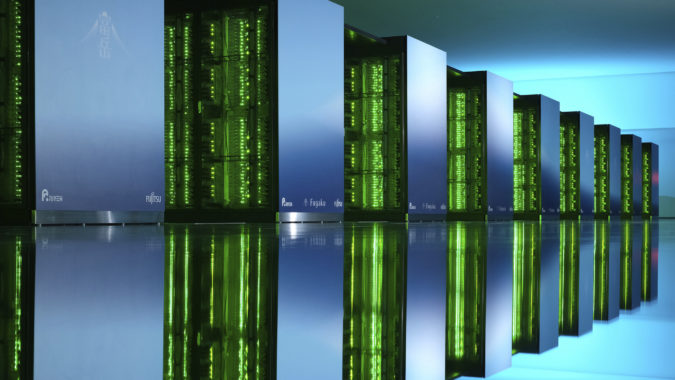RIKEN took the supercomputing world by storm last summer when it launched Fugaku – which became (and remains) the world’s most powerful supercomputer – nearly a year ahead of schedule in order to perform crucial, time-sensitive research on the pandemic. With Fugaku’s one-year anniversary on the Top500 swiftly approaching and the pandemic well past the one-year mark, RIKEN is now looking back on a year of COVID research with the supercomputer and outlining where its projects stand.
RIKEN explains that it began its COVID research with five core priorities identified by the RIKEN President’s Fund:
- the publication of data and research using cutting-edge, large-scale, joint-use facilities;
- the development of diagnostic methods;
- the development of therapies;
- research to help people and communities overcome the crisis, and;
- basic research, including the development of technology to visualize the life cycle of the virus, genome analysis, epigenetic analysis and the study of host-gut microbiome interactions.
Throughout the pandemic, RIKEN also made a name for itself in viral particle simulations, investigating how infectious SARS-CoV-2 particles could travel through various facial coverings (masks, face shields, etc.), spaces (schools, trains, etc.) and environmental conditions (e.g. high and low humidity). Much of that work is discussed in this feature article.

However, RIKEN’s work extends far beyond those simulations. Even with the pandemic seeming to wane in the face of warmer weather and vaccines across much of the world, RIKEN remains hard at work on a wide range of COVID-related activities, ranging from the development of new vaccines to the social sciences.
Diagnostics
RIKEN calls diagnostic work a “major focus.” Crucially, RIKEN differentiated itself from the most common method for diagnosing COVID-19: the polymerase chain reaction (PCR) test. Instead, RIKEN developed a proprietary nucleic acid-based test, which itself is distinct from nucleic acid amplification tests (NAATs) insofar as RIKEN’s test is able to detect individual molecules of viral RNA and, as a result, does not require amplification.
The method also separates the test sample into “hundreds of compartments,” each testing negative or positive, allowing for a measurement of overall concentration. If this measurement is not important, a test takes just ten minutes. RIKEN reports that the proprietary testing method is not yet ready for high-throughput mass screening, but that in initial testing, its sensitivity approximates that of the highly reliable PCR tests.
RIKEN is now working on combining this proprietary nucleic acid testing technology with CRISPR technology to develop a new detection method that hones in on SARS-CoV-2 using a guide RNA that separates the novel coronavirus from other coronaviruses.
Drug development – and a new vaccine
Likely the highest-profile aspect of COVID research during the pandemic has been drug discovery. Early in the pandemic, a team used RIKEN’s resources to run 10 days of protein-ligand molecular dynamics simulations on Fugaku to test thousands of candidate drug compounds, identifying 30 existing medications as candidates for effective COVID-19 treatments. Another team took a less conventional approach, using a quantum mechanics method to study interactions of a few hundred viral protein structures using RIKEN’s fragment molecular orbital (FMO) database. In terms of ongoing drug discovery work, RIKEN researchers are currently investigating a host cell surface protein involved in virus entry, and RIKEN says that “further therapeutic goals include the development of a COVID-19 antibody drug.”
 RIKEN is also working on a new approach to vaccines to compensate for possible shortcoming of the current vaccine approach. The current vaccines, RIKEN notes, are complicated by mutations in SARS-CoV-2 and the occasional occurrence of antibody-dependent enhancement (ADE) that can increase disease severity.
RIKEN is also working on a new approach to vaccines to compensate for possible shortcoming of the current vaccine approach. The current vaccines, RIKEN notes, are complicated by mutations in SARS-CoV-2 and the occasional occurrence of antibody-dependent enhancement (ADE) that can increase disease severity.
RIKEN’s new vaccine technology, called mMAP – for mutation compatible multiple antigen peptides – targets regions of the spike protein that were found to remain unchanged between not only SARS-CoV-2 and its variants, but also SARS-CoV-1 and even MERS-CoV. These regions, RIKEN says, are not likely to mutate, and a vaccine targeting them may be able to head off a wide range of coronaviruses, possibly including the viruses as they appear in animals (SARS-CoV-2 is thought to have originated zoonotically). Such a vaccine is currently under development by Ken-ichi Masuda’s team at RIKEN’s Vaccine Innovation Laboratory.
The rest
Variable responses
RIKEN is working on understanding why certain COVID-19 patients develop very severe symptoms while others do not. To do this, the institute is working with researchers from the Tokyo Medical and Dental University to contribute to the COVID Human Genetics Effort, which aims to identify genome sequences associated with those more severe reactions.
Microbiomes
RIKEN is investigating fecal samples from recovered COVID-19 patients to understand whether certain bacterial strains could enhance the body’s immune response, hoping to develop therapeutics (and again, better understand variability in reactions) based on the findings.
Basic research
RIKEN says that it is currently supporting basic research through the development of an AI system that processes published research papers and analyzes their biomedical data.
The social sciences
RIKEN’s work isn’t constrained to the natural sciences: the institute also says it’s working on studying the social impacts of COVID-19, including the social effects of teleworking and hate speech analysis powered by machine learning.
To learn more about RIKEN’s COVID projects, follow this link.




























































